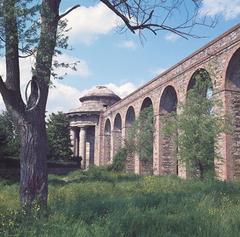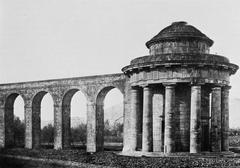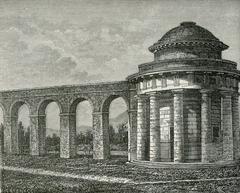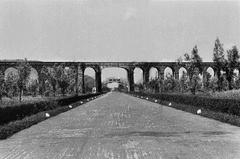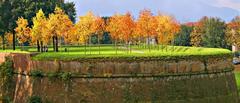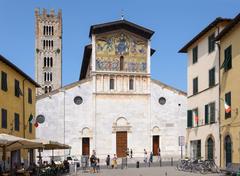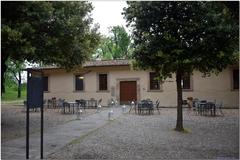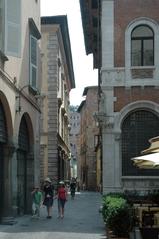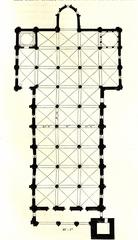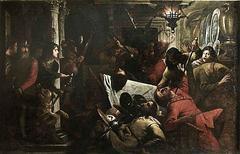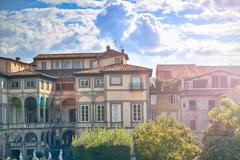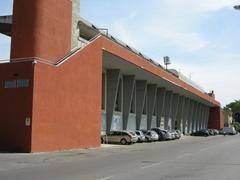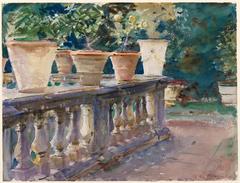
Tempietto di San Concordio: Visiting Hours, Tickets, and Travel Guide in Lucca, Italy
Date: 14/06/2025
Introduction
The Tempietto di San Concordio is a striking symbol of Lucca’s commitment to civic progress and architectural sophistication. Located just outside the city’s historic southern walls, this 19th-century neoclassical temple was designed by the renowned architect and engineer Lorenzo Nottolini. Serving as the final cistern and filtration point for Lucca’s monumental aqueduct, the Tempietto not only played a pivotal role in improving public health, but also stands today as a beloved landmark, blending classical beauty with engineering innovation (visittuscany.com; Comune di Lucca).
This comprehensive guide will help you plan your visit, covering the site’s origins, significance, architectural features, practical travel details, and tips for exploring Lucca’s rich historical landscape.
Table of Contents
- Historical Background: Lucca’s Water Supply and the Nottolini Aqueduct
- Architectural and Engineering Highlights
- Visiting the Tempietto di San Concordio: Hours, Tickets, and Accessibility
- Practical Tips and Nearby Attractions
- Restoration and Community Significance
- Frequently Asked Questions (FAQ)
- Further Resources and References
Historical Background: Lucca’s Water Supply and the Nottolini Aqueduct
Water Supply Challenges Before the 19th Century
Prior to the construction of the Nottolini Aqueduct, Lucca’s residents depended on shallow wells, often contaminated and unreliable, which led to recurring public health crises. Wealthier households sometimes had access to cleaner water from the hills, but most citizens faced the risks of waterborne disease and inadequate supply (visittuscany.com).
Vision and Construction
Recognizing the urgent need for a modern water system, Maria Luisa of Spain, Duchess of Lucca, commissioned Lorenzo Nottolini to design an aqueduct in 1822. Construction began in 1823 and continued until 1851, overcoming financial and technical challenges. The resulting structure spanned over 3 kilometers and featured nearly 460 elegant brick and stone arches, channeling spring water from the Monte di Vorno and Serra Vespaiata hills into Lucca (capannori-terraditoscana.org; nomads-travel-guide.com).
The Tempietto di San Concordio: The Aqueduct’s Culmination
At the city’s threshold, the Tempietto di San Concordio was constructed between 1823 and 1825. This neoclassical temple-cistern marked the aqueduct’s endpoint and the transition from rural to urban water distribution. Designed in the Doric style, it housed filtration mechanisms to purify water before it entered the city’s network (Comune di Lucca).
Architectural and Engineering Highlights
Neoclassical Design
The Tempietto’s circular plan and Doric colonnade evoke ancient Roman temples, reflecting the neoclassical ideals of harmony, order, and civic virtue. The structure, about 10 meters in diameter, features:
- Robust Doric columns encircling a domed roof
- Marble basins for water sedimentation and purification
- A simple entablature emphasizing geometric clarity (Bella Toscana)
Engineering Innovations
Nottolini’s design included:
- Sophisticated filtration systems using layers of stone and grates for sedimentation
- Gravity-fed water distribution—no pumps required
- Thermal expansion protection for iron pipes, ensuring consistent flow and durability (Wikipedia)
Urban Impact
The aqueduct dramatically improved Lucca’s public health by providing clean water to public and private fountains, with the finest water reserved for drinking. The system operated purely by gravity, and the aqueduct’s arches became an iconic feature of the local landscape (capannori-terraditoscana.org).
Visiting the Tempietto di San Concordio: Hours, Tickets, and Accessibility
Opening Hours and Admission
- Open-air monument: Accessible year-round, 24/7; best visited during daylight hours for safety and photography.
- Admission: Free; no tickets required.
- Interior access: Generally closed, but occasional special openings or guided tours may provide entry.
Accessibility
- Paths are flat and suitable for wheelchairs and strollers, though some areas may be uneven.
- No on-site amenities (restrooms, cafés), but these are available at Lucca train station or in the city center.
How to Get There
- From Lucca train station: About a 5-minute walk south along Viale Regina Margherita; the Tempietto marks the start of the aqueduct’s arches (Edilbuild).
- From the city center: A 20-minute walk or short bike ride through Porta San Pietro.
- By car: Limited parking is available nearby; walking or cycling is recommended for the best experience.
Practical Tips and Nearby Attractions
What to Bring and When to Visit
- Comfortable shoes for walking or cycling
- Sun protection (hat, sunscreen) in summer
- Camera: Early morning and late afternoon offer the best light
- Best seasons: Spring and autumn for pleasant weather and fewer crowds (OverYourPlace)
Combine Your Visit
- Walk or cycle the aqueduct south to the Tempietto di Guamo for a scenic tour.
- Lucca’s City Walls: The Renaissance-era walls are ideal for a panoramic stroll (TheTravelFolk).
- Historic Center: Don’t miss the Duomo di San Martino, Piazza dell’Anfiteatro, and other architectural gems.
Guided Tours and Events
While not always included in standard city tours, several local operators offer specialized walks highlighting the aqueduct and Tempietto. During cultural events or heritage days, special guided access may be available (Welcome2Lucca).
Restoration and Community Significance
Recent investments by the Comune di Lucca and Unicoop Firenze have ensured the structural integrity and ongoing preservation of the Tempietto and the first aqueduct arches. Restoration projects have reinforced the monument’s role as a community landmark, with residents and visitors alike valuing its blend of history, utility, and beauty (La Nazione).
The site now serves not only as a historical monument but as a recreational hub for walking, cycling, and community events, fostering civic pride and heritage stewardship.
Frequently Asked Questions (FAQ)
Q: What are the visiting hours for Tempietto di San Concordio?
A: The site is accessible 24/7 as an open-air monument, best visited during daylight hours.
Q: Is there an entry fee or tickets required?
A: No—admission is free.
Q: Are guided tours available?
A: Some local operators offer guided tours that include the Tempietto and the aqueduct. Check with the Lucca tourist office.
Q: Is the site accessible for people with mobility issues?
A: Yes, the area is mostly flat and suitable for wheelchairs and strollers, though minor uneven sections exist.
Q: What is the best time of year to visit?
A: Spring and autumn offer mild weather and beautiful scenery.
Essential Contacts and Resources
- Lucca Tourist Office: https://www.turismo.lucca.it/
- Emergency Services (Italy): Dial 112
References and Further Reading
- visittuscany.com
- capannori-terraditoscana.org
- nomads-travel-guide.com
- Bella Toscana
- Comune di Lucca
- Welcome2Lucca
- Edilbuild
- La Nazione
- OverYourPlace
- TheTravelFolk
Conclusion
The Tempietto di San Concordio invites both locals and travelers to experience the intersection of Lucca’s historical ingenuity, neoclassical artistry, and vibrant community spirit. Whether you’re exploring on foot, cycling along the aqueduct, or seeking a deeper understanding of urban innovation, this site stands as a living monument to the city’s enduring commitment to public health, architectural elegance, and civic pride.
For further inspiration and practical visitor guidance, download the Audiala app, explore our related articles, and follow us on social media for up-to-date tips and events.
Images and interactive maps are available in our gallery section to enhance your virtual or in-person visit.
